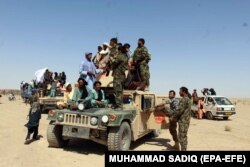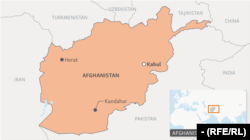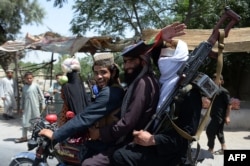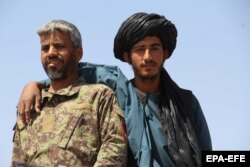Several thousand scruffy Taliban fighters streamed into the Afghan capital on motorcycles and in overcrowded cars, waving the militant group's white flags. But they came not as combatants, but as civilians taking advantage of a cease-fire that saw them celebrate the Islamic holiday of Eid al-Fitr alongside sworn enemies with feasts, hugs, and selfies.
It was a scene that was replicated across the country, where government forces have been trying to stave off Taliban militants ever since their hard-line Islamic regime was toppled by a U.S.-led invasion in 2001.
"It was the first peaceful Eid I celebrated," said Mohammad Alam, a resident of the eastern province of Logar, capturing the newfound optimism over the possibility of a lasting truce. "We have hope. Peace is the only way."
Peace might be the only way, but the glimpse of what it might look like was fleeting. Not long after the June 15-17 cease-fire observed by both the Taliban and government was over, deadly Taliban attacks resumed.
Still, the temporary cessation of hostilities was enough to serve as a litmus test of the public's, government's, and Taliban's openness to ending the war, and to get locals and observers alike thinking: what might a lasting peace in this war-torn country look like?
(Not) Talking To The Taliban
Peace talks with the Taliban have proved elusive for the past decade.
The United States and Afghanistan attempted to split the Taliban by offering moderates amnesty; pursued a "talk and fight" strategy to compel the group to negotiate; opened a Taliban political office in Qatar for talks; teamed up with Pakistan and China to set up direct talks with the Taliban; and heaped pressure on Pakistan, the Taliban's main foreign backer, to force them to the negotiating table.
But all these efforts failed. The Taliban said it will not talk directly to Kabul, which it sees as a U.S. puppet. The militant group has also demanded the withdrawal of foreign troops from Afghanistan as a precondition for talks. Meanwhile, the United States said it supported an Afghan-led peace process and would not deal directly with the Taliban.
"The main obstacles have been opposition by the U.S., differences in the Afghan side, Pakistan's desire to use the insurgency and the peace process to achieve its own goals, mistrust and conflict between Afghanistan and Pakistan, and the unwillingness of Taliban to publicly renounce ties to Al-Qaeda," Barnett Rubin, a former U.S. State Department official and leading expert on Afghanistan, told RFE/RL.
Bridging The Gaps
Afghan President Ashraf Ghani came into office in 2014 just as tens of thousands of international troops were pulling out of the country. Left with a threadbare foreign presence and growing Taliban violence, Ghani made it his priority to remove obstacles to peace talks with the Taliban by trying to build regional consensus.
His early attempts failed, but he has made a renewed effort in recent months. There has been a flurry of talks in Kabul and Islamabad aimed at easing tensions, as the United States has shown renewed interest in peace efforts.
Ghani has offered unconditional talks with the Taliban and has made unprecedented concessions aimed at luring militants back into the fold of society, including recognizing the militant group as a political party. His efforts have received backing from Muslim clerics who have issued rulings delegitimizing the Taliban insurgency on religious grounds.
The Afghan government's unilateral cease-fire from June 12 to June 20 and the Taliban's June 15-17 truce was the culmination of these efforts. Kabul has since extended its cessation of hostilities by 10 days until June 30, which was not reciprocated by the militants.
The first bilateral truce during the Taliban's 17-year insurgency against Afghan and foreign forces prompted extraordinary scenes across Afghanistan. In villages and towns around the country, Taliban fighters hugged, presented flowers, and posed for photos with government officials. Euphoric crowds of civilians also took part in the festivities.
"The cease-fire showed that public pressure for peace is growing," said Thomas Ruttig, co-director of the Afghanistan Analysts Network, an independent think tank in Kabul. "There is a yearning for a peaceful life also among the Taliban fighters."
Newfound cooperation between the main parties of the conflict was key to the successful truce.
The United States and Afghanistan have long accused Islamabad of harboring the Taliban and have heaped pressure on Pakistan to bring the militants to the negotiating table. Islamabad denies that it backs the Taliban.
In a sign that the three countries are bridging their differences, the Afghanistan and the United States conducted an air assault on June 14 that killed Pakistani Taliban leader Mullah Fazlullah in eastern Afghanistan. The Pakistani Taliban are waging an insurgency against the Pakistani state. Pakistan had alleged Kabul was turning a blind eye to the presence of Pakistan Taliban fighters in Afghanistan.
"This is an indication of better Afghanistan-Pakistan-U.S. cooperation, though we need to remember that this remains a triangle rife with mistrust," said Michael Kugelman, South Asia associate at the Woodrow Wilson International Center for Scholars in Washington. "Any cooperation will remain transactional. There will need to be a comparative advantage dynamic at play where one is always able to provide something another needs."
Taliban Return 'Scares Me'
Checking the widespread optimism, the Taliban's presence in large urban centers during the cease-fire prompted trepidation and suspicion among the general population. The militant group has killed tens of thousands of Afghan civilians through vicious suicide bombings, gun attacks, and rocket assaults over the past 17 years.
The brief cessation of hostilities also exposed the spoilers that could attempt to thwart any peace efforts, as evidenced by two deadly suicide bombings that were claimed by the Islamic State (IS) extremist group, an enemy of both the Taliban and the Afghan government that was not included in the cease-fire.
"[The] Taliban's physical existence in Kabul city scares me," Sahar Fetrat, a producer with the Moby Group, which makes some of Afghanistan's most popular television shows, said during the truce. "I can feel the calm before the storm. As much as I try to stay positive, reconciliation doesn't happen in just one day."
Omar Samad, an analyst and former Afghan ambassador who has advised senior Afghan officials, said the cease-fire has opened a window of opportunity that needs to be managed wisely and that takes Afghan national interests into account.
"Reality lies somewhere between absolute state of euphoria and skepticism," Samad said. "It is foolish to jump to conclusions or to ignore the multilayered internal and external complexities [of reaching peace]."
Kugelman said any future reconciliation will have to overcome those opposed to a negotiated settlement.
"These range from the harder line factions of the Taliban to those within the Afghan political class who are wary, for good reason, of trying to engage a violent organization with retrograde views," said Kugelman. "The IS group is the most murderous spoiler, which will capitalize on any peace efforts to try to expand its own activities and prove that reconciling with the Taliban alone won't bring peace."
'Renewed Momentum'
Analysts said the opportunity created by the successful, yet brief, cease-fire needs to be seized upon.
"We learned that a cease-fire is doable, and that the Taliban also can implement it -- which is a sign of hope for when a genuine peace process starts," said Ruttig. "There needs to be serious attempts now to get talks going between the three main actors in the war -- the Afghan government, the Taliban, and the United States."
Kugelman said the cease-fire had provided "a major building block" for the government's efforts to negotiate a peace deal with the Taliban.
"The good news is that there's renewed momentum to pursue reconciliation," he said. "The bad news is there's still no clear plan, and the Taliban ultimately has no incentive to step off the battlefield."
Samad said that "now is the time for intra-Afghan consultation by the government to develop an inclusive and credible strategy to reduce risks and opt for a process that has popular backing."
"We are at the very early stages of talks about talks," he said.
Despite the considerable obstacles that still need to be navigated, the brief pause in fighting was taken by many Afghans as a step, no matter how small, in the right direction.
"We hope that this cease-fire will be the beginning of a new era of peace and unity in Afghanistan," said Mohammad Reza, a resident of the southern province of Uruzgan. "The cease-fire has shown people that there is another way."












